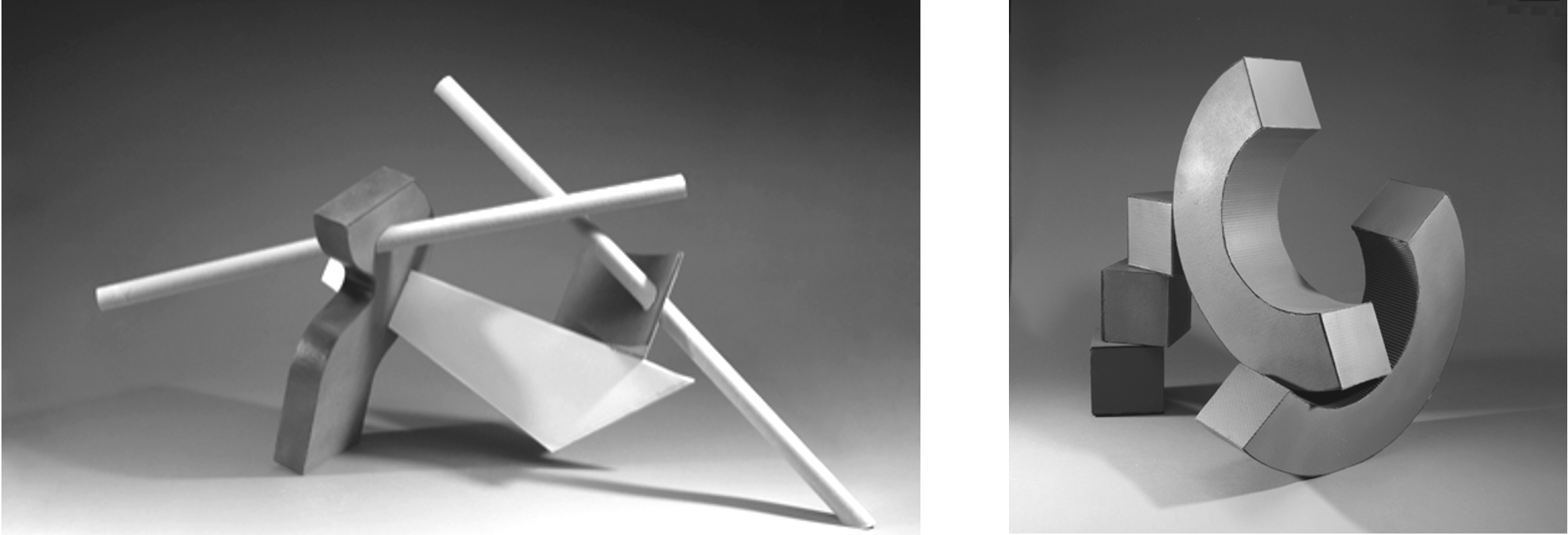MULTIPLE SHAPES
Students should note that this is a sample assignment. Instructors may alter its contents, and referring to the materials given directly by the instructor will always be the most accurate.
OBJECTIVES
- Gain experience designing and building non-representational forms that focuses on an effective use of visual movement and an organization of space using design principles.
- Determine strongest method of display (floor, pedestal, wall, hanging, etc.)
THE ASSIGNMENT
Part 1:
You will layout, cut and construct a cube using cardboard, tape, Elmer’s glue and/or hot glue. Using 6 square planes, the finished cube will measure 5 inches along each edge from vertex to vertex. The thickness of the material must be considered for accuracy of measurement. Edges should be extremely clean; gaps and visible glue are discouraged, as they make for poor craftsmanship. Surfaces should be free of dirt, fingerprints, pencil marks and glue.
Part 2:
You will use four or more individual, geometric solid forms in combination to create one unified finished work that is an example of good 3D composition. They can be combined in a multitude of ways (they could be on top, leaning against, or intersect one another); your decisions should be made to achieve the best compositional organization of space. You will need to use color in this sculpture. Keep in mind that your finished project is not restricted to any given size. That said, it is suggested that you keep it to no larger than three feet in any direction.
Part of this project requires that you make a model (also called a maquette) of your idea before you begin your final construction. This maquette will be made from manila folders and about a ¼ scale of your final sculpture.
Specific Requirements:
1. You MUST use at least four individual forms, and those forms may be any regular or irregular shapes that you choose. The forms you create must be enclosed and have volume; meaning just using a flat piece of cardboard cutout into a shape is not acceptable. You will add color, but no more two individual colors (white and black will not be considered a colors).
2. All the forms must be glued/attached together in some way. The only exception to this would be that if your composition requires forms to be separate from the others. Otherwise, everything should be attached together.
3.You must attempt to effectively address at least three of the design principles listed in the resolution of this assignment. See the vocabulary list below. You will be expected to explain how you used those
Part 1:
You will layout, cut and construct a cube using cardboard, tape, Elmer’s glue and/or hot glue. Using 6 square planes, the finished cube will measure 5 inches along each edge from vertex to vertex. The thickness of the material must be considered for accuracy of measurement. Edges should be extremely clean; gaps and visible glue are discouraged, as they make for poor craftsmanship. Surfaces should be free of dirt, fingerprints, pencil marks and glue.
Part 2:
You will use four or more individual, geometric solid forms in combination to create one unified finished work that is an example of good 3D composition. They can be combined in a multitude of ways (they could be on top, leaning against, or intersect one another); your decisions should be made to achieve the best compositional organization of space. You will need to use color in this sculpture. Keep in mind that your finished project is not restricted to any given size. That said, it is suggested that you keep it to no larger than three feet in any direction.
Part of this project requires that you make a model (also called a maquette) of your idea before you begin your final construction. This maquette will be made from manila folders and about a ¼ scale of your final sculpture.
Specific Requirements:
1. You MUST use at least four individual forms, and those forms may be any regular or irregular shapes that you choose. The forms you create must be enclosed and have volume; meaning just using a flat piece of cardboard cutout into a shape is not acceptable. You will add color, but no more two individual colors (white and black will not be considered a colors).
2. All the forms must be glued/attached together in some way. The only exception to this would be that if your composition requires forms to be separate from the others. Otherwise, everything should be attached together.
3.You must attempt to effectively address at least three of the design principles listed in the resolution of this assignment. See the vocabulary list below. You will be expected to explain how you used those
VOCABULARY
- Emphasis
- Focal Point
- Visual Balance
- Lift
- Repetition
- Tension
- Variety
- Asymmetry
MATERIALS
Cardboard, White Glue, Hot Glue, Drafting Tape, Xacto Knife, Cutting Board, Ruler, 45-Degree Triangle, Protractor, 220 grit Sandpaper
Cardboard, White Glue, Hot Glue, Drafting Tape, Xacto Knife, Cutting Board, Ruler, 45-Degree Triangle, Protractor, 220 grit Sandpaper
The content and writing for this project were provided by Travis Graves.

